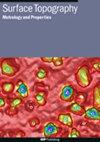劈裂霍普金森压力棒对玻璃纤维增强聚合物复合材料应变速率的影响
IF 2
3区 材料科学
Q2 ENGINEERING, MECHANICAL
引用次数: 0
摘要
摘要本研究的目的是研究玻璃纤维增强聚合物(GFRP)复合材料在[0°/90°]s、[±45]s、[0°/+45°/−45°/90°]T三种不同取向下的应力应变行为。为了实现这一点,使用ABAQUS/CAE中的Split Hopkinson Bar (SHPB)设置对GFRP进行了模拟。在三种不同的速度下(9.7 m s−1、12.7 m s−1和14.3 m s−1)使用冲击杆,产生的应变率范围从1000 s−1到2000 s−1。考虑GFRP复合材料的应力-应变特性,对其动力响应进行了研究。通过完整的应力应变曲线分析了应变率对玻璃钢复合材料弹性模量和吸能能力的影响。结果表明:GFRP复合材料的弹性模量和吸能能力对应变速率敏感,应变速率的增大导致弹性模量和吸能能力的增大;本文章由计算机程序翻译,如有差异,请以英文原文为准。
Effect of strain rate on glass fiber reinforced polymer composite using split hopkinson pressure bar
Abstract The aim of this study is to examine the stress–strain behavior of Glass Fibre Reinforced Polymer (GFRP) composite with three different orientations, namely [0°/90°]s, [±45]s, [0°/+45°/−45°/90°] T . To achieve this, the GFRP was simulated using the Split Hopkinson Bar (SHPB) setup in ABAQUS/CAE. The striker bar was used at three different velocities (9.7 m s −1 , 12.7 m s −1 , and 14.3 m s −1 ) to produce strain rates ranging from 1000 s −1 to 2000 s −1 . The dynamic response of the GFRP composite was studied by considering its stress–strain behavior. The effect of strain rate on the elastic modulus and energy absorption capacity of GFRP laminates was analyzed through complete stress versus strain curves. The results showed that the elastic modulus and energy absorption capacity of GFRP laminates were sensitive to strain rates, with an increase in strain rate leading to an increase in the elastic modulus and energy absorption capacity.
求助全文
通过发布文献求助,成功后即可免费获取论文全文。
去求助
来源期刊

Surface Topography: Metrology and Properties
Materials Science-Materials Chemistry
CiteScore
4.10
自引率
22.20%
发文量
183
期刊介绍:
An international forum for academics, industrialists and engineers to publish the latest research in surface topography measurement and characterisation, instrumentation development and the properties of surfaces.
 求助内容:
求助内容: 应助结果提醒方式:
应助结果提醒方式:


